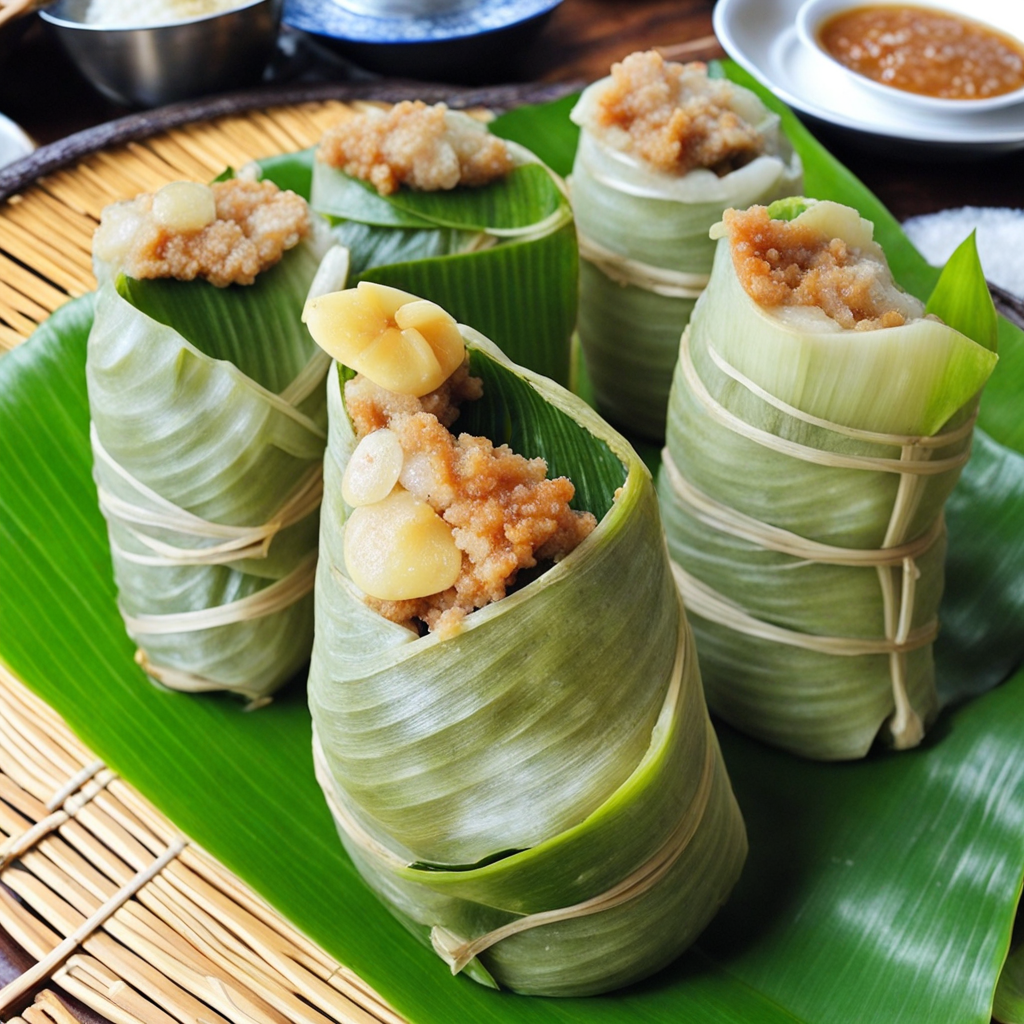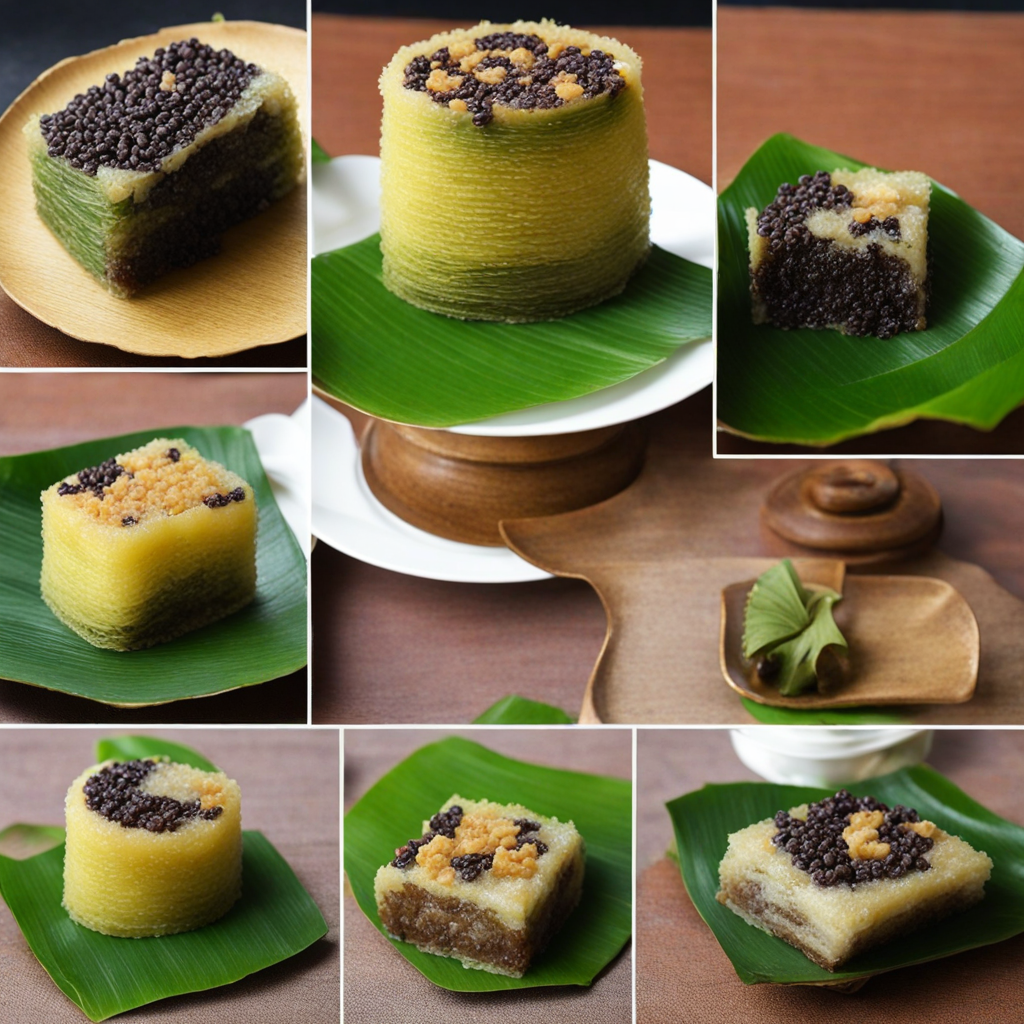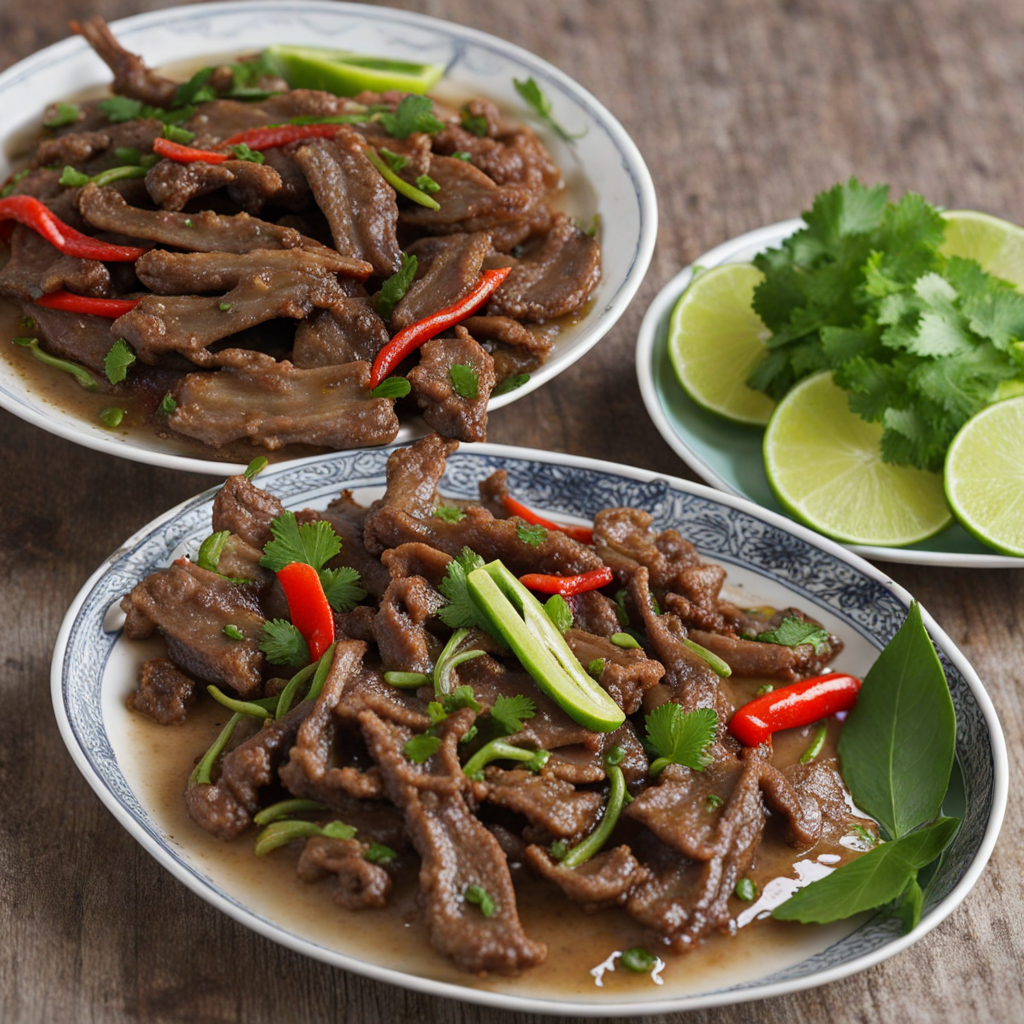Num Ansom Chek
Num Ansom Chek is a traditional Cambodian delicacy that embodies the rich flavors and culinary heritage of the region. This dish consists of glutinous rice, which is skillfully mixed with a savory filling of shredded chicken, along with a medley of spices that enhance its taste. Wrapped in banana leaves, the mixture is then steamed to perfection, allowing the flavors to meld beautifully. The result is a fragrant and comforting dish that is both visually appealing and satisfying to the palate.
The texture of Num Ansom Chek is one of its defining features. The glutinous rice, once steamed, transforms into a sticky and chewy consistency that contrasts wonderfully with the tender, juicy chicken filling. The banana leaves not only provide a natural wrapping but also impart a subtle aroma, making each bite a delightful experience. This dish is often enjoyed as a snack or a light meal, and it showcases the art of balancing flavors and textures, a hallmark of Cambodian cuisine.
How It Became This Dish
The Enchanting History of នំអន្សមចេក (Num Ansorm Chek) #### Introduction Nestled in the heart of Cambodia’s culinary landscape, *Num Ansorm Chek* (នំអន្សមចេក) is a delectable treat deeply intertwined with the country’s cultural heritage. This traditional banana sticky rice cake embodies not just a unique flavor but also a rich historical narrative that showcases the resilience and creativity of the Cambodian people. To understand the significance of Num Ansorm Chek, we must explore its origins, cultural relevance, and the evolution of its preparation over time. #### Origins The roots of Num Ansorm Chek can be traced back to the ancient civilizations of Southeast Asia, where rice has been a staple food for millennia. In Cambodia, rice cultivation is believed to have begun around 2,000 years ago, with the fertile plains around the Mekong River providing ideal conditions for rice farming. As rice became integral to Cambodian agriculture, various culinary practices emerged, including the use of glutinous rice, which is essential in the making of Num Ansorm Chek. The name *Num Ansorm Chek* translates to “banana sticky rice cake,” which perfectly encapsulates its primary ingredients. The dish is typically made from glutinous rice, fresh bananas, coconut milk, and sugar, which are combined to create a sweet, moist, and aromatic cake. The use of bananas is particularly significant, as the fruit is abundant in Cambodia and symbolizes prosperity and fertility in Khmer culture. #### Cultural Significance Num Ansorm Chek holds a special place in Cambodian culture, often associated with significant ceremonies, festivals, and communal gatherings. This treat is commonly prepared during celebrations such as Khmer New Year and Pchum Ben (a festival honoring deceased ancestors). The act of making Num Ansorm Chek is often a communal effort, bringing families and neighbors together, fostering a sense of community and shared heritage. In the context of Khmer spirituality and tradition, food plays a pivotal role in rituals and celebrations. Num Ansorm Chek is often offered to spirits during religious ceremonies, serving as a way to honor ancestors and invoke blessings for the family. The sweet flavor and inviting aroma are believed to attract positive energies, making it an essential offering during important events. Moreover, Num Ansorm Chek is a representation of Cambodian resilience and creativity. During the Khmer Rouge regime in the late 1970s, traditional cooking practices faced severe disruption. Many families resorted to simpler, more basic forms of sustenance. However, through the hardships, the cultural significance of dishes like Num Ansorm Chek endured. Post-regime, the revival of traditional food practices became a form of cultural reclamation and identity restoration, with Num Ansorm Chek standing as a symbol of hope and resilience. #### Development Over Time Over the centuries, the preparation of Num Ansorm Chek has evolved, influenced by regional variations and modern culinary practices. Traditionally, the dish was made by soaking glutinous rice overnight, followed by steaming it in banana leaves, which impart a subtle fragrance to the rice. The bananas, often ripe and sweet, are added before the mixture is wrapped and steamed again, allowing the flavors to meld beautifully. As Cambodia opened up to globalization in the 1990s, culinary practices began to diversify. While traditional methods of preparing Num Ansorm Chek remain widely practiced, contemporary variations have emerged, reflecting global influences and the availability of new ingredients. For instance, some modern recipes incorporate additional flavors, such as pandan or jackfruit, enhancing the dish’s complexity. Others may use coconut cream instead of plain coconut milk for a richer taste. Furthermore, Num Ansorm Chek has found its way into the modern culinary scene, with chefs experimenting with different presentations and pairings. In urban areas, it is not uncommon to find Num Ansorm Chek served in upscale restaurants, reimagined as a gourmet dessert that pays homage to its traditional roots while appealing to a broader audience. The rise of food tourism in Cambodia has also played a crucial role in popularizing Num Ansorm Chek. As international travelers seek authentic culinary experiences, local food markets and street vendors have embraced this demand, showcasing Num Ansorm Chek as part of Cambodia’s vibrant food culture. Cooking classes and workshops centered around traditional dishes have also become popular, allowing visitors to engage with the local culture while learning to make this iconic treat. #### A Symbol of Unity and Heritage As Cambodia continues to navigate the complexities of modernization and globalization, Num Ansorm Chek remains a steadfast symbol of unity and heritage. It embodies the spirit of the Cambodian people, reflecting their ability to adapt and innovate while honoring their traditions. The dish serves as a reminder of the importance of community, family, and the shared experiences that define Cambodian culture. In recent years, there has been a renewed interest in preserving traditional food practices and promoting local ingredients. Efforts to sustain the cultivation of heritage rice varieties and the use of locally sourced bananas have gained momentum, ensuring that the essence of Num Ansorm Chek is maintained for future generations. #### Conclusion Num Ansorm Chek is more than just a delicious dessert; it is a living testament to Cambodia’s rich history and cultural resilience. From its ancient origins in rice cultivation to its role in contemporary culinary practices, this sweet sticky rice cake continues to captivate the hearts and palates of Cambodians and visitors alike. As the world becomes increasingly interconnected, the story of Num Ansorm Chek serves as a reminder of the importance of preserving cultural heritage through food, celebrating the flavors that bind communities together, and honoring the past while looking toward the future.
You may like
Discover local flavors from Cambodia







